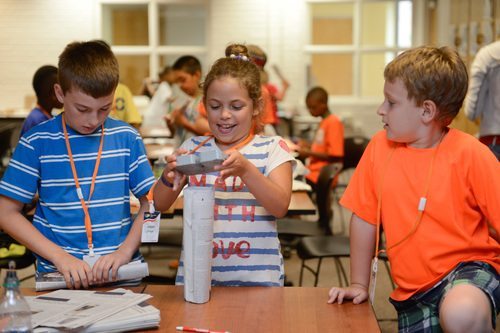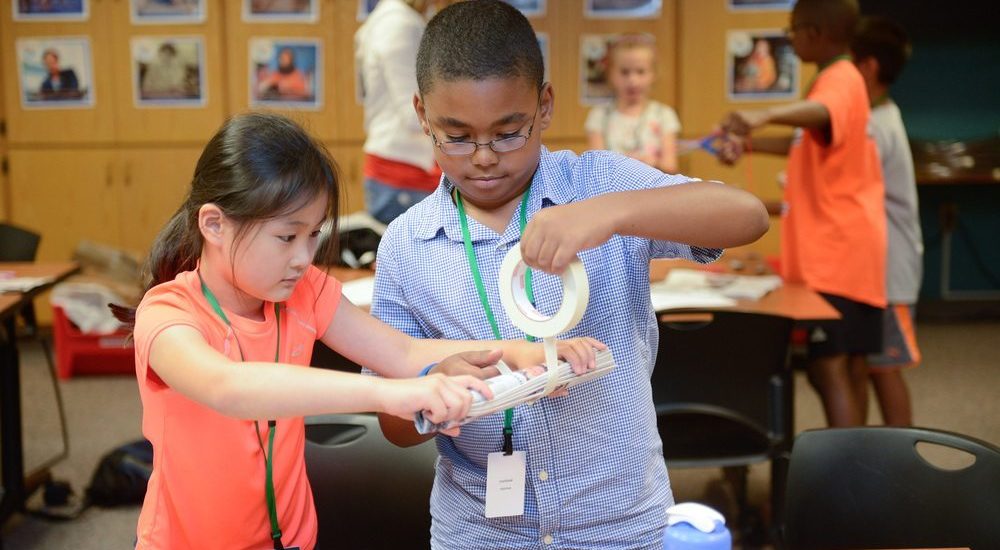In at least two ways, out-of-school programs are little different from their school-day counterparts.
For one, STEM education is popular and widely available. Nearly 70 percent of out-of-school programs offer some kind of STEM content.
For another, engineering, the “E” in STEM, is the least developed part of the picture. As with K-12 schools, out-of-school programs focus far more on science and math. Engineering, the driving force behind all the tools and technologies that make our lives easier, safer, healthier, more productive, and even more enjoyable, is largely absent.
Such does not have to be the case. Engineering, especially through the lens of design thinking, can be accessible and fun for students and teachers alike. And since we live our lives in an engineered, designed world much more than in the natural world, an acquaintance with engineering can be seen as a basic, even necessary, part of living fully in the modern world.
For many reasons, out-of-school programs lend themselves especially well to STEM learning.
• Outside the realm of standardized or curricular testing, they allow a space for learning to take shape through experimentation and failure without fear of penalty.
• Taking place in varied settings, out-of-school programs provide ready opportunities for hands-on, experiential learning, connected directly to places and objects relevant to kids’ daily lives.
• An open leadership structure allows mentors and role models from the community to participate, especially meaningful to kids from underrepresented groups who might not otherwise encounter people in STEM fields who look like them.
As it happens, these attributes of learning programs frequently appear in models suggested for use in pre-college engineering education and outreach. Even so, engineering remains the least-common topic offered in the out-of-school STEM world. The America After 3PM survey presented STEM-related results in “Full STEM Ahead.”
This report found STEM topics appearing in this order of frequency:
• Math, 60 percent of STEM programs
• Science, 45 percent
• Technology and Engineering, 30 percent
Even the 30 percent figure almost certainly obscures the low profile of engineering in the field. “Technology” programs would presumably include computer-oriented activities, which Google search results suggest are more prevalent than “engineering” programs.
• “Technology after school” generated 15,600 items.
• “Computer after school” generated 15,400.
• “Engineering after school” generated 9,140.
Admittedly imprecise, these results at least suggest the contours of what’s available for kids to choose from.
So much the worse for engineering – one of the strengths of STEM out-of-school programming is the appeal to exactly the populations engineering has difficulty reaching.
• Girls participate at a rate almost equal to boys; among students with STEM opportunities, 73 percent of girls and 80 percent boys sign up.
• African-American and Hispanic children participate at 80 percent rates, while white children do so at 77 percent.
• And studies have shown that out-of-school program participation can reduce achievement gaps between students from low-income families and those from high-income families.

A full analysis of how out-of-school STEM programs can work most effectively appears in the National Academy of Engineering’s report, Identifying and Supporting Productive STEM Programs in Out-of-School Settings. This report reviews multiple sources to make the case that out-of-school STEM programs play vital roles in promoting learning, exciting kids about future opportunities, and breaking down barriers that under-represented groups face in formal education settings. Given these opportunities, engineering would be well served indeed by mounting a more robust effort to establish a profile in out-of-school program activities.
However, as noted in “Full STEM Ahead,” “the afterschool field often states that it is ideally situated for technology and engineering programs and yet it appears that this potential is far from realized.” Why would this be so?
We surveyed the 1,500-some readers of our blog, Start Engineering Now, to find out what they thought the obstacles to out-of-school engineering were.
The top three answers, by far, were:
• Program leaders have trouble teaching engineering, 56 percent
• Equipment and supplies are hard or expensive to get, 51 percent
• Instructional materials are not available, 31 percent
These results, in fact, should not discourage. Engineering is primarily about solving problems and improving lives. It is a process for finding solutions by asking questions, imagining answers (even far-fetched), testing out and improving these answers where they come up short, and then delivering a reliable tool for users to deploy in their daily lives. It thrives on innovative thinking, communication and collaboration, persistence, attention to detail, and a focus on people’s real needs.

In higher education or at work, knowledge of math and science is certainly required. In K-12 and out-of-school, though, the engineering design process matters most.
And through this angle of approach, engineering sets up nicely as an afterschool activity, readily taught, with materials to implement it cheap or even free.
Help in various forms is available from nearly every college with an engineering program, all the major engineering societies, and any number of local companies in the engineering and technology sector.
Our own efforts at Start Engineering are squarely directed at making engineering a viable, low-cost undertaking for educators even with no training in the field. In our blog, for example, we ran a series last fall on failure, design, and relevance in engineering, effectively an introduction to educators starting to think about making the topic part of their teaching and learning work.
For engineering to become a bigger part of out-of-school learning, two things need to happen:
Engineering educators have to meet afterschool programs where they live, furnishing appropriate materials and stepping in with expert assistance as needed. Afterschool program leaders can start surveying the engineering learning landscape, looking for suitable points of entry for them and their students. They do exist, and they do not require extensive technical content knowledge.
Neither side in this scenario faces an impossible task. In the true make-it-up-and-make-it-happen spirit of engineering, it’s time to get started with this work, see what works and what doesn’t, and go on from there.
For breakfast, I had a bowl of cereal with strawberries and blueberries, grapefruit juice, and two cups of coffee (well, maybe three…).
Author Profile: @ericiversen
Image credit: Start-Engineering Blog
